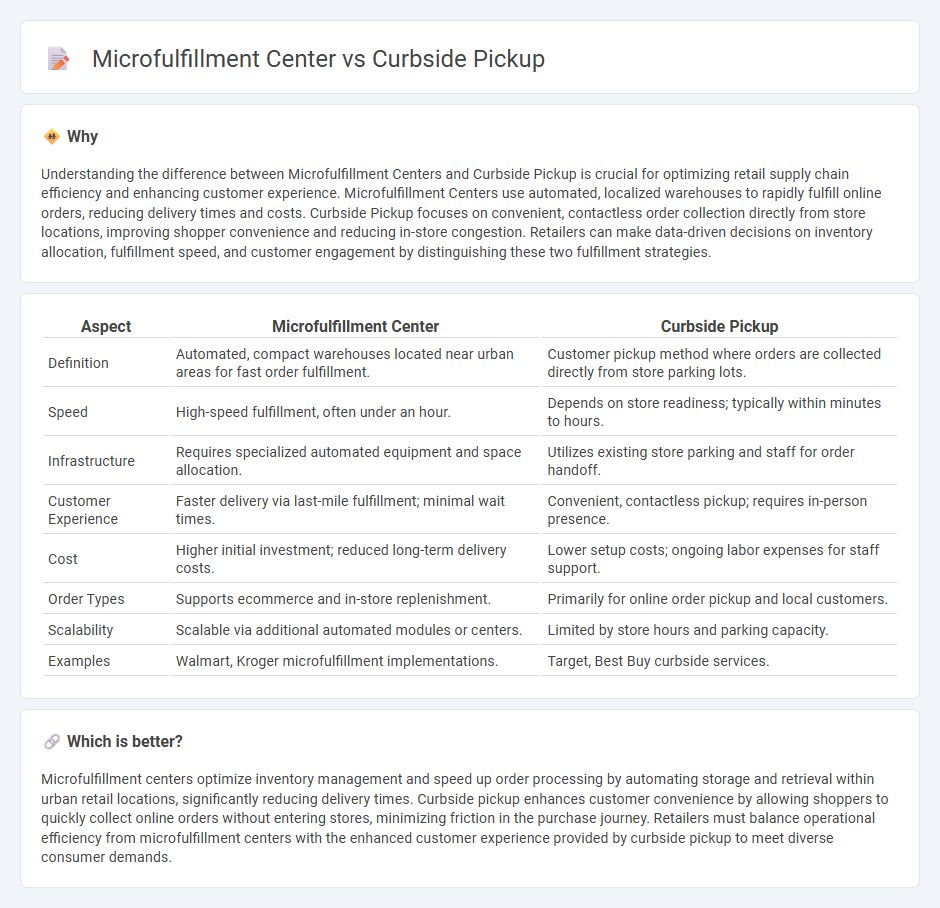
Microfulfillment centers leverage automated technology to rapidly process online retail orders within urban environments, enhancing inventory efficiency and reducing delivery times. Curbside pickup offers shoppers a convenient, contactless option to collect orders directly from store parking lots, blending e-commerce ease with physical retail accessibility. Explore how these innovative retail solutions transform customer experiences and operational workflows.
Why it is important
Understanding the difference between Microfulfillment Centers and Curbside Pickup is crucial for optimizing retail supply chain efficiency and enhancing customer experience. Microfulfillment Centers use automated, localized warehouses to rapidly fulfill online orders, reducing delivery times and costs. Curbside Pickup focuses on convenient, contactless order collection directly from store locations, improving shopper convenience and reducing in-store congestion. Retailers can make data-driven decisions on inventory allocation, fulfillment speed, and customer engagement by distinguishing these two fulfillment strategies.
Comparison Table
| Aspect | Microfulfillment Center | Curbside Pickup |
|---|---|---|
| Definition | Automated, compact warehouses located near urban areas for fast order fulfillment. | Customer pickup method where orders are collected directly from store parking lots. |
| Speed | High-speed fulfillment, often under an hour. | Depends on store readiness; typically within minutes to hours. |
| Infrastructure | Requires specialized automated equipment and space allocation. | Utilizes existing store parking and staff for order handoff. |
| Customer Experience | Faster delivery via last-mile fulfillment; minimal wait times. | Convenient, contactless pickup; requires in-person presence. |
| Cost | Higher initial investment; reduced long-term delivery costs. | Lower setup costs; ongoing labor expenses for staff support. |
| Order Types | Supports ecommerce and in-store replenishment. | Primarily for online order pickup and local customers. |
| Scalability | Scalable via additional automated modules or centers. | Limited by store hours and parking capacity. |
| Examples | Walmart, Kroger microfulfillment implementations. | Target, Best Buy curbside services. |
Which is better?
Microfulfillment centers optimize inventory management and speed up order processing by automating storage and retrieval within urban retail locations, significantly reducing delivery times. Curbside pickup enhances customer convenience by allowing shoppers to quickly collect online orders without entering stores, minimizing friction in the purchase journey. Retailers must balance operational efficiency from microfulfillment centers with the enhanced customer experience provided by curbside pickup to meet diverse consumer demands.
Connection
Microfulfillment centers streamline inventory management by enabling rapid order assembly near urban areas, which significantly accelerates curbside pickup services. The proximity of microfulfillment centers to customers reduces delivery times, enhancing the efficiency and convenience of curbside pickup. This integration supports retailers in meeting growing consumer demand for quick, contactless shopping experiences.
Key Terms
Order Fulfillment
Curbside pickup streamlines order fulfillment by enabling customers to retrieve online purchases directly from the store, reducing last-mile delivery costs and wait times. Microfulfillment centers optimize fulfillment by leveraging automation and proximity, accelerating order processing and boosting inventory accuracy through advanced robotics technology. Explore how these order fulfillment strategies can enhance your retail operations and customer experience.
Inventory Management
Curbside pickup relies on decentralized inventory management, often causing discrepancies between online stock levels and actual availability at individual stores, leading to potential fulfillment challenges. Microfulfillment centers use automated, localized warehouses with real-time inventory tracking, enabling faster, more accurate order processing and improved stock optimization. Discover how integrating microfulfillment technology can revolutionize your inventory management strategy.
Last-Mile Delivery
Curbside pickup streamlines last-mile delivery by reducing delivery times and lowering transportation costs through customer-driven order collection directly at store premises or designated areas. Microfulfillment centers optimize inventory management with automated, compact warehouses placed closer to urban centers, enhancing order fulfillment speed and accuracy while minimizing delivery distances. Explore how integrating these solutions can revolutionize your last-mile logistics strategy and improve customer satisfaction.
Source and External Links
How Does Curbside Pickup Work? Everything you need to know - Curbside pickup means placing an order online and then driving to the store where staff brings your order directly to your car, offering a quick and convenient way to get items without going inside the store.
Curbside Pickup | The Home Depot - Customers select curbside pickup at checkout, check in via the store app upon arrival, park in a designated spot, and store employees bring the order and load it into the vehicle; pickup is typically available daily from 9 a.m. to 6 p.m..
Fast Store Pickup | Best Buy - Curbside pickup at Best Buy allows you to drive up to the store and have staff bring your eligible items to your car in a contactless, fast, and free process during store hours.
 dowidth.com
dowidth.com